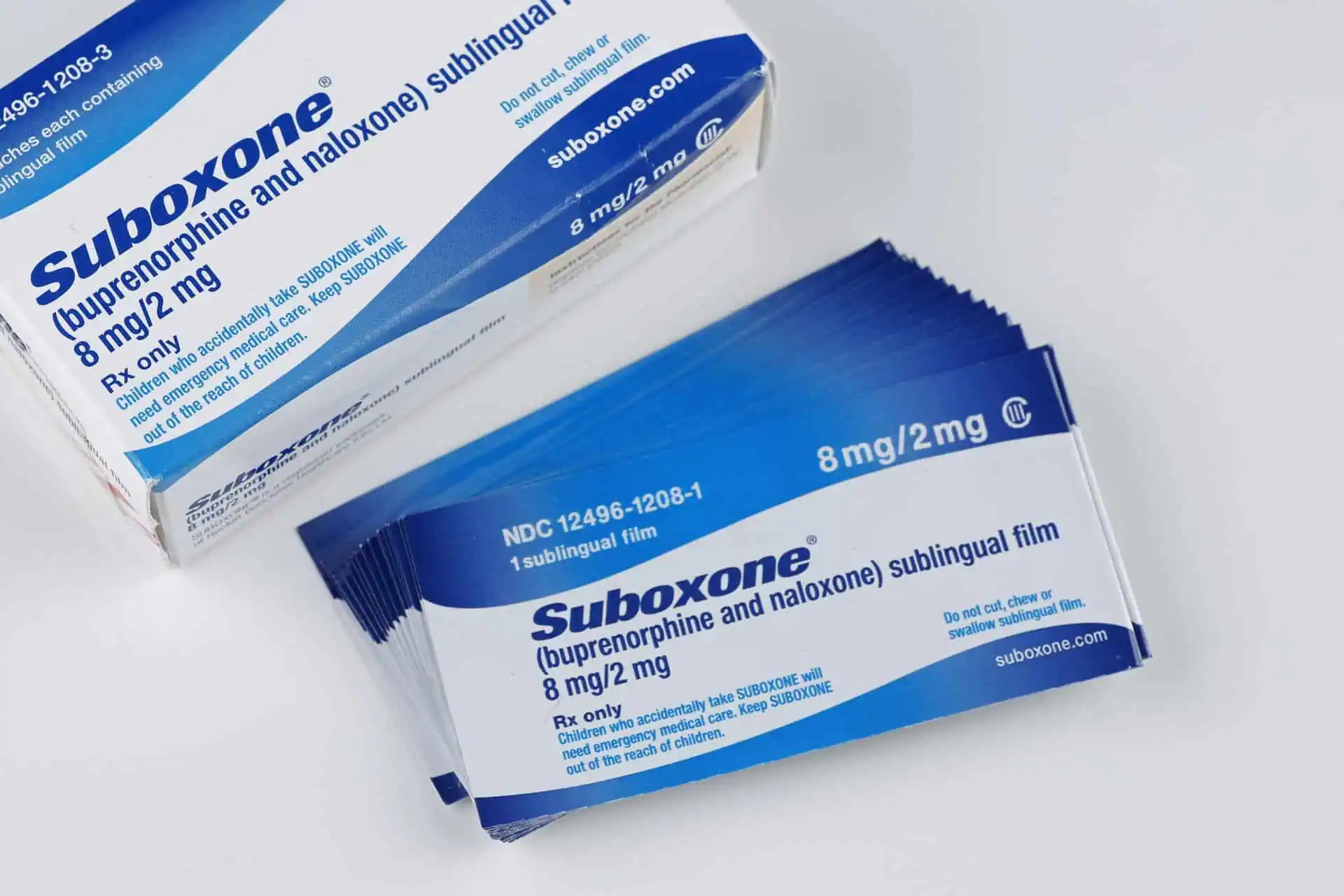Buprenorphine Tooth Decay Lawsuit
- Last Updated: June 12th, 2025

Attorney Jessica Paluch-Hoerman, founder of TruLaw, has over 28 years of experience as a personal injury and mass tort attorney, and previously worked as an international tax attorney at Deloitte. Jessie collaborates with attorneys nationwide — enabling her to share reliable, up-to-date legal information with our readers.
Legally Reviewed
This article has been written and reviewed for legal accuracy and clarity by the team of writers and legal experts at TruLaw and is as accurate as possible. This content should not be taken as legal advice from an attorney. If you would like to learn more about our owner and experienced injury lawyer, Jessie Paluch, you can do so here.
Fact-Checked
TruLaw does everything possible to make sure the information in this article is up to date and accurate. If you need specific legal advice about your case, contact us by using the chat on the bottom of this page. This article should not be taken as advice from an attorney.
Key takeaways:
- The Buprenorphine Tooth Decay Lawsuit involves claims that the medication causes severe dental issues such as tooth decay, cavities, gum disease, and tooth loss. Plaintiffs allege that manufacturers failed to adequately warn about these risks.
- Multidistrict Litigation (MDL) has been established in the Northern District of Ohio to consolidate Suboxone tooth decay cases. Bellwether trials are being conducted to set precedents and determine potential outcomes for other lawsuits.
- Plaintiffs in Suboxone lawsuits seek compensation for dental expenses, pain and suffering, lost wages, and loss of quality of life. Factors influencing settlements include the severity of dental issues, duration of Suboxone use, and the impact on the plaintiff's daily life.
Overview of the Buprenorphine Tooth Decay Lawsuit
On this page, we’ll provide an overview of the Buprenorphine Tooth Decay Lawsuit, consolidation of Suboxone dental issue claims, impact of the Buprenorphine Tooth Decay Lawsuit on healthcare, and much more.
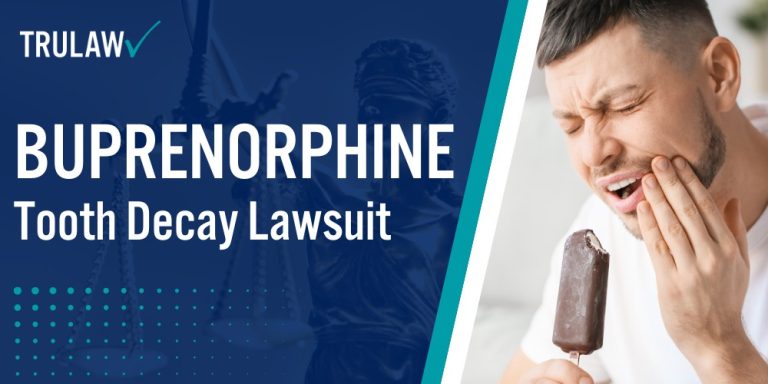
Intro to the Buprenorphine Tooth Decay Lawsuit
The Buprenorphine Tooth Decay Lawsuit involves claims that the medication causes severe dental issues, such as:
- Tooth decay
- Cavities
- Gum disease
- Tooth loss
- Oral infections
- Enamel erosion
- Bone loss
- Other severe dental problems
If you or a loved one has suffered significant dental harm after taking Buprenorphine, you may be eligible for compensation.
Contact TruLaw using the chat on this page to receive an instant case evaluation to see if you qualify to file a Buprenorphine dental injury lawsuit.
Table of Contents
Progression of the Buprenorphine Tooth Decay Lawsuit
The Buprenorphine tooth decay lawsuit has been a significant legal development, with numerous plaintiffs coming forward to seek justice for dental damages allegedly caused by the medication.
The progression of this lawsuit involves key events that have shaped its current status, including pivotal legal arguments made by both plaintiffs and defendants.
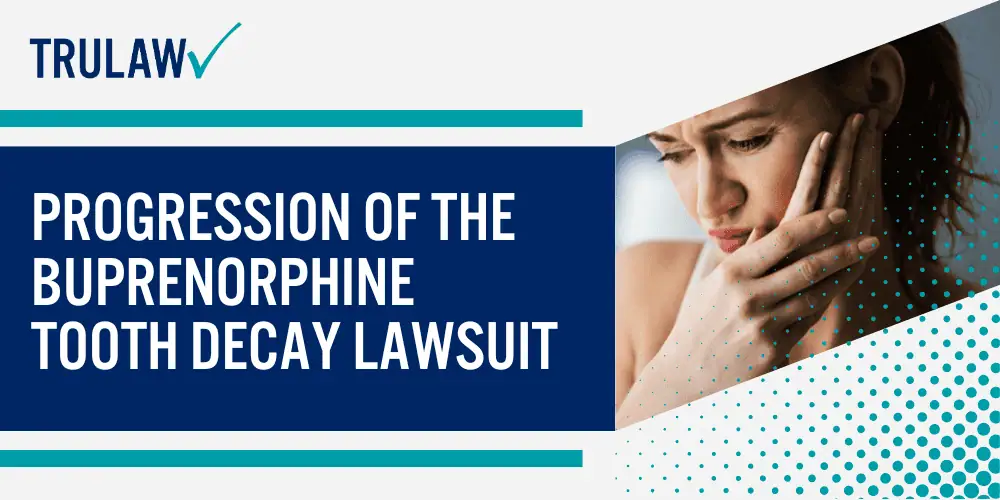
Plaintiffs allege that the manufacturers of Buprenorphine failed to warn users about these risks, leading to significant dental harm.
Knowledge of these developments is essential for anyone affected by sublingual buprenorphine naloxone exposure.
Key Events in the Buprenorphine Lawsuit Timeline
The timeline of the Buprenorphine tooth decay lawsuit is marked by several critical events.
These events have collectively shaped the progression of the case, highlighting the legal maneuvers involved in addressing the claims.
Key events in the Buprenorphine tooth decay lawsuits include, but are not limited to:
- Initial Filings: The first lawsuits were filed by individuals who experienced severe dental injuries after using Buprenorphine.
- MDL Formation: To streamline the legal process, the cases were consolidated into a Multidistrict Litigation (MDL) in the Northern District of Ohio.
- Bellwether Trials: Selected cases were tried as bellwether trials to test the waters for potential outcomes in other cases.
- Settlement Negotiations: Ongoing discussions between plaintiffs and defendants aim to reach a settlement agreement.
These events illustrate the trajectory of the lawsuit and the major milestones that have occurred.
The progression of these events underscores the complexity of the litigation process and the importance of strategic legal maneuvers.
Each event has contributed to shaping the current status of the lawsuit and will likely influence its future direction.
Major Legal Arguments in the Buprenorphine Lawsuit
The legal arguments in the Buprenorphine tooth decay lawsuit revolve around several key points.
Plaintiffs argue that the manufacturers failed to warn users about the risk of tooth decay associated with Buprenorphine use.
They also claim that the medication’s formulation contributes to dental damage.
On the other hand, defendants contend that the warnings provided were adequate and that other factors could contribute to tooth decay.
These arguments are central to the case, influencing the court’s decisions and the potential outcomes for plaintiffs.
Plaintiffs Legal Strategy in the Buprenorphine Lawsuit
Plaintiffs in the Buprenorphine Tooth Decay Lawsuit are typically individuals who have been prescribed buprenorphine as part of their treatment for opioid addiction.
These individuals have suffered from severe dental problems, which they allege are directly linked to their use of the medication.
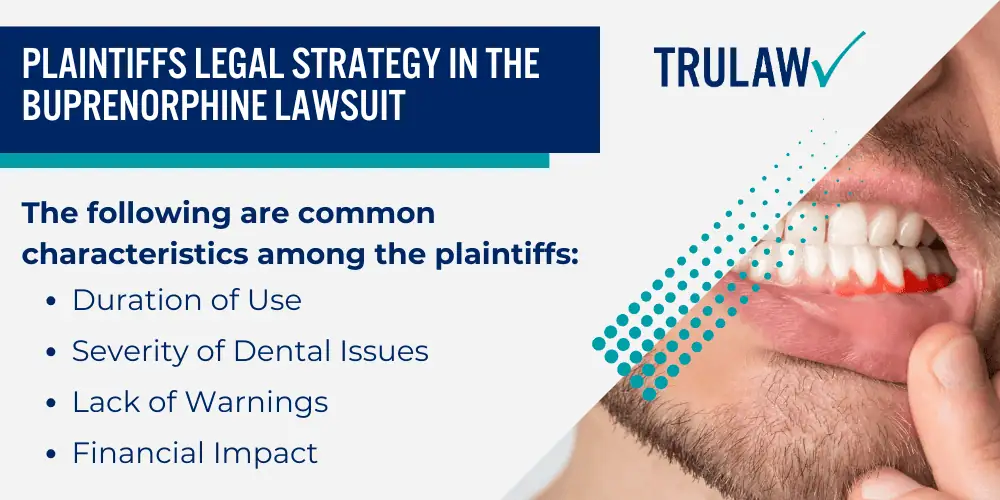
The following are common characteristics among the plaintiffs:
- Duration of Use: Many plaintiffs have used buprenorphine for extended periods, often for several months or years, as part of their opioid addiction treatment.
- Severity of Dental Issues: Plaintiffs report experiencing severe dental issues, including tooth decay, cavities, broken teeth, and tooth loss, necessitating extensive dental treatments.
- Lack of Warnings: A key allegation is that plaintiffs were not adequately warned about the potential dental risks associated with buprenorphine, leading to preventable dental damage.
- Financial Impact: The cost of dental treatments and related expenses has placed a significant financial burden on plaintiffs, many of whom are seeking compensation to cover these costs.
These plaintiffs argue that the lack of adequate warnings and information about the dental risks of buprenorphine use has led to unnecessary suffering and financial hardship.
By joining the lawsuit, they aim to hold the manufacturer accountable and obtain the compensation needed to address their dental health issues.
Legal Strategies Employed by Plaintiffs’ Attorneys
Attorneys representing plaintiffs in the Buprenorphine tooth decay lawsuit employ various strategies to strengthen their cases.
These strategies aim to provide compelling evidence and persuasive arguments to achieve successful outcomes for plaintiffs.
Legal strategies include utilizing expert testimonies, presenting scientific evidence, citing case precedents, and engaging in settlement negotiations.
These approaches help build a strong case for plaintiffs, increasing their chances of obtaining favorable outcomes.
Medical Evidence and Expert Testimonies
Medical evidence and expert testimonies play a significant role in the Suboxone tooth decay litigation.

Scientific studies linking Buprenorphine to dental issues provide the foundation for plaintiffs’ claims, while expert testimonies offer professional insights that can sway the court’s decisions.
However, proving causation remains a significant challenge in these cases.
Studies Linking Buprenorphine to Tooth Decay
Several studies have investigated the potential link between Buprenorphine use and tooth decay.
These studies provide scientific backing for the claims made by plaintiffs, supporting the argument that Buprenorphine contributes to tooth decay.
Studies linking Buprenorphine to tooth decay include:
- Journal of Dental Research (2020): Found a higher incidence of dental caries in patients using Buprenorphine found in Suboxone sublingual films.
- JAMA Study (2022):Compared sublingual buprenorphine/naloxone with transdermal buprenorphine and oral naltrexone. Found increased risk of adverse dental outcomes associated with sublingual buprenorphine/naloxone
- Brigham and Women’s Hospital Case Series: Reported significant dental health decline in patients following buprenorphine treatment initiation.Subjects reported various dental issues including caries, fillings, cracked teeth, and extractions
- FDA Safety Review (2022): Identified 305 cases of dental problems associated with buprenorphine use.131 cases classified as serious. Median time to diagnosis was approximately two years after starting treatment
- Addiction Resource Study (2013): Examined Suboxone opioid addiction treatmentfor nearly four years, three times a day. Found significant dental problems, including toothaches and tooth decay
These studies offer credible evidence that supports the plaintiffs’ claims.
The findings from these studies are instrumental in establishing a scientific basis for the lawsuit.
They help to validate the plaintiffs’ claims and provide a foundation for the arguments presented in court.
Challenges in Proving Causation in the Buprenorphine Cases
Proving causation in tooth decay Suboxone lawsuits involves several challenges.
These include the influence of multiple factors on dental health, variability in symptoms among users, and the lack of extensive long-term studies on Buprenorphine’s dental effects.
Addressing these challenges requires comprehensive medical evidence and persuasive expert testimonies, which are essential for plaintiffs to successfully prove their claims and obtain the compensation they seek.
Consolidation of Suboxone Tooth Decay Cases
The consolidation of Buprenorphine tooth decay cases through Multidistrict Litigation (MDL) and bellwether trials is a pivotal aspect of the legal process.
This approach aims to streamline the handling of numerous similar cases and establish precedents that can influence the outcomes of subsequent trials.
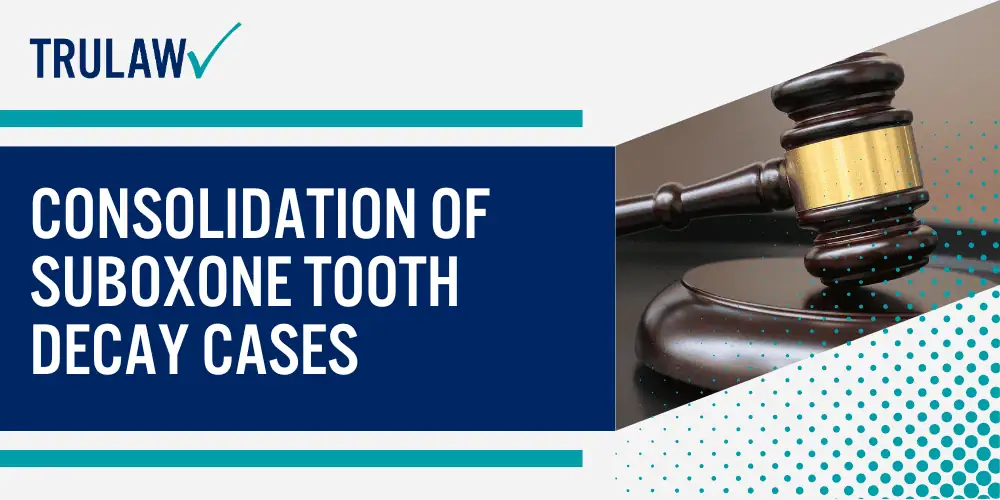
Reviewing the MDL process and the role of bellwether trials is essential for grasping the broader implications of the lawsuit.
Multidistrict Litigation (MDL) in Northern District of Ohio
Multidistrict Litigation (MDL) involves the consolidation of multiple cases into a single court to improve efficiency and consistency.
The MDL in the Northern District of Ohio serves as the focal point for Suboxone tooth decay claims, shaping the direction and outcomes of the litigation.
Key aspects of MDL include:
- Centralization: Cases are transferred to one court for pretrial proceedings.
- Consistency: MDL ensures uniformity in rulings and settlements across similar cases.
- Efficiency: Streamlines the legal process, reducing redundant efforts in handling individual cases.
- Coordination: Facilitates coordination among plaintiffs’ attorneys, enhancing their collective legal strategy.
The MDL process helps manage the caseload effectively and ensures consistent legal outcomes.
The consolidation under MDL not only enhances judicial efficiency but also provides a structured framework for managing the litigation.
It allows for a more organized approach to addressing the numerous cases involved in the Suboxone teeth lawsuits.
Bellwether Trials in Buprenorphine Cases
Bellwether trials are selected cases that are tried first to set precedents for other lawsuits.
These trials play a significant role in determining the legal strategies and expectations for other plaintiffs.
By selecting representative cases that reflect common issues and circumstances, bellwether trials provide insights into potential outcomes for remaining cases and can drive settlement negotiations.
They also help manage the caseload by resolving key issues early on, which is instrumental in shaping the overall direction of the cases.
Impact of the Buprenorphine Tooth Decay Lawsuit on Healthcare
The Buprenorphine tooth decay lawsuit has significant implications for the healthcare industry, affecting both providers and prescribing practices.
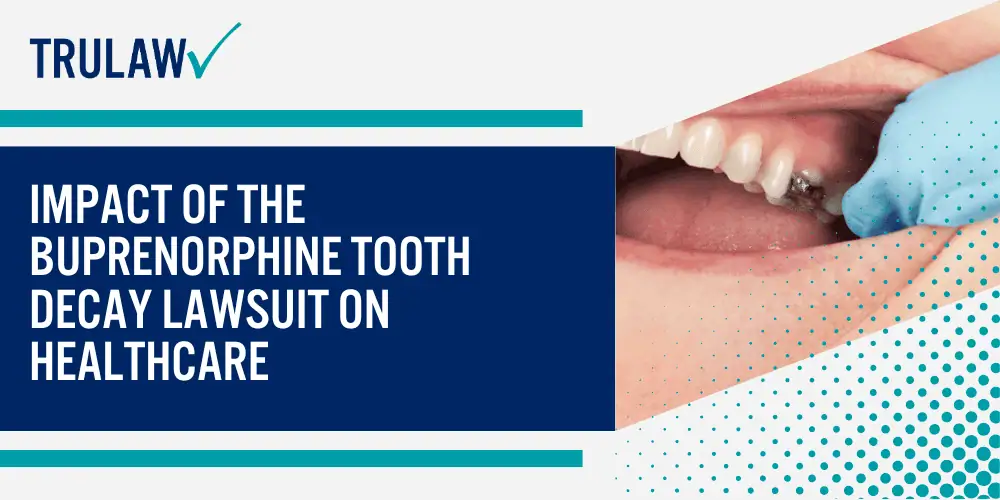
The lawsuit’s outcomes may lead to changes in how Buprenorphine is prescribed and monitored, as well as how healthcare providers respond to legal and medical concerns related to the medication.
Healthcare Providers’ Response to the Lawsuit
Healthcare providers have reacted to the Suboxone lawsuit in several ways.
These responses aim to minimize the risk of dental harm and ensure better patient outcomes.
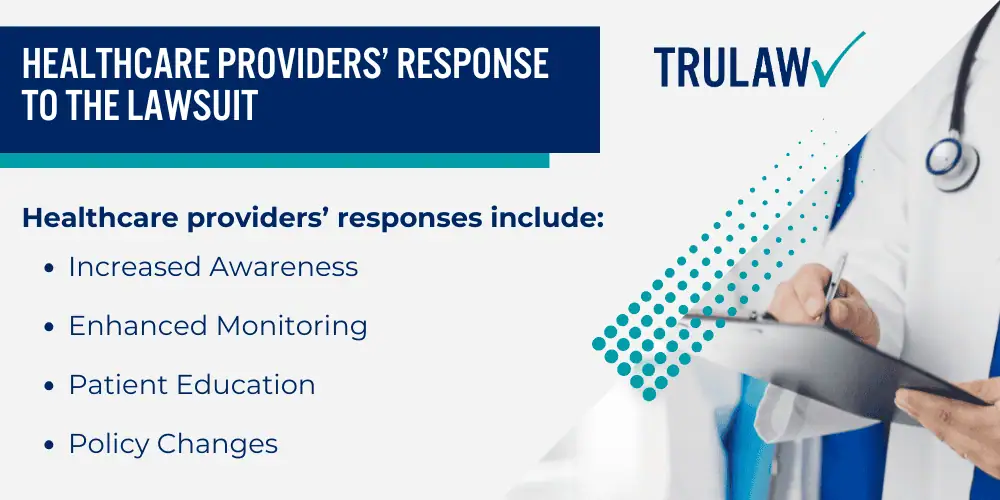
Healthcare providers’ responses include:
- Increased Awareness: Heightened awareness of the potential dental risks associated with Buprenorphine.
- Enhanced Monitoring: Implementation of more rigorous dental monitoring protocols for patients on Buprenorphine.
- Patient Education: Improved patient education on oral hygiene practices to mitigate the risk of tooth decay.
- Policy Changes: Adjustments to prescribing policies to address legal and medical concerns.
These measures reflect the proactive steps taken by healthcare providers in response to the lawsuit.
The healthcare providers’ responses are critical in addressing the concerns raised by the lawsuit.
By implementing these changes, they aim to provide better care and prevent potential dental issues related to Buprenorphine use.
Changes in Buprenorphine Prescribing Practices
The lawsuit has prompted changes in how Buprenorphine is prescribed.
Healthcare providers have adopted stricter prescribing guidelines to prevent overuse and misuse, mandated regular dental check-ups for patients using Buprenorphine, and explored alternative treatments for opioid addiction with fewer dental side effects.
Enhanced documentation and reporting of dental issues in patients on Buprenorphine are also part of these changes, reflecting the healthcare industry’s commitment to patient safety and better management of potential side effects.
Regulatory and Industry Reactions to the Buprenorphine Lawsuit
The Buprenorphine tooth decay lawsuit has garnered attention from regulatory bodies and the pharmaceutical industry, prompting various reactions.
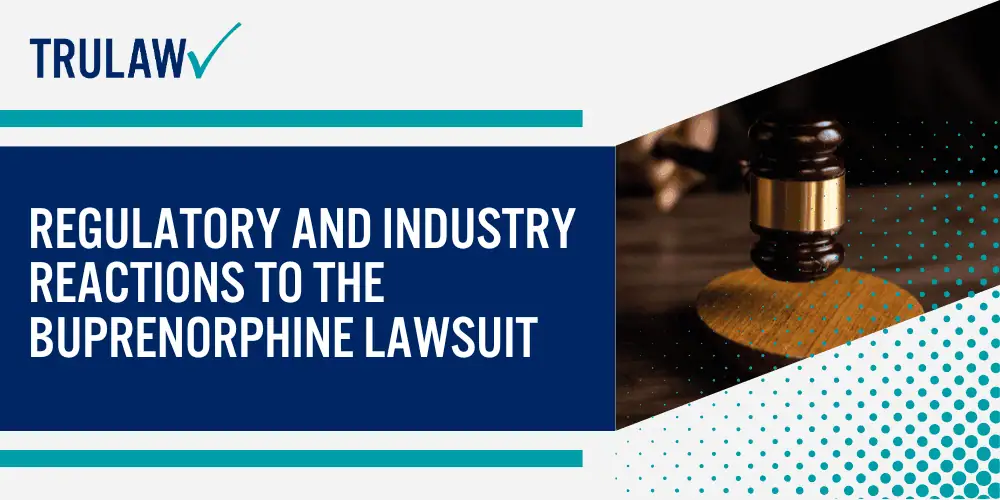
Regulatory agencies like the FDA are involved in monitoring the situation and implementing changes, while the industry responds by adjusting practices and policies to mitigate legal risks.
FDA and Other Regulatory Bodies’ Involvement
Regulatory bodies have taken several steps in response to the lawsuit.
These actions demonstrate the regulatory commitment to addressing the dental health concerns associated with Buprenorphine.
Regulatory actions include:
- Safety Reviews: Conducting safety reviews of Buprenorphine to assess the risk of tooth decay.
- Labeling Changes: Requiring changes to medication labeling to include warnings about potential dental risks.
- Guideline Updates: Updating treatment guidelines to incorporate dental health considerations.
- Monitoring Programs: Implementing monitoring programs to track dental outcomes in patients using Buprenorphine.
These measures are designed to enhance patient safety and address the issues raised by the lawsuit.
The involvement of regulatory bodies is vital in ensuring that the concerns related to Buprenorphine are adequately addressed.
Their actions help to establish safety standards and provide guidelines for safer use of the medication.
Industry-Wide Changes Resulting from the Lawsuit
The pharmaceutical industry has made several adjustments in response to the lawsuit.
These changes reflect the industry’s efforts to mitigate the impact of the lawsuit and improve patient safety.
Industry-wide changes include investing in research to develop formulations with reduced dental side effects, enhancing risk management strategies to address potential legal liabilities, implementing patient support programs to assist with dental health issues, and strengthening compliance measures to adhere to regulatory requirements.
These adjustments aim to address the concerns raised by the lawsuit and ensure better patient outcomes.
Potential Compensation and Settlements for Plaintiffs
Plaintiffs in the Buprenorphine tooth decay lawsuit seek various forms of compensation for their dental injuries.
The potential compensation and settlements depend on several factors, including the severity of the dental damage and the specifics of each case.

Reviewing the types of compensation sought and the factors influencing settlement amounts provides insight into the potential outcomes for plaintiffs.
Types of Compensation Sought in the Buprenorphine Lawsuit
Plaintiffs typically seek compensation for various damages.
These types of compensation aim to address the various harms suffered by plaintiffs and provide financial relief.
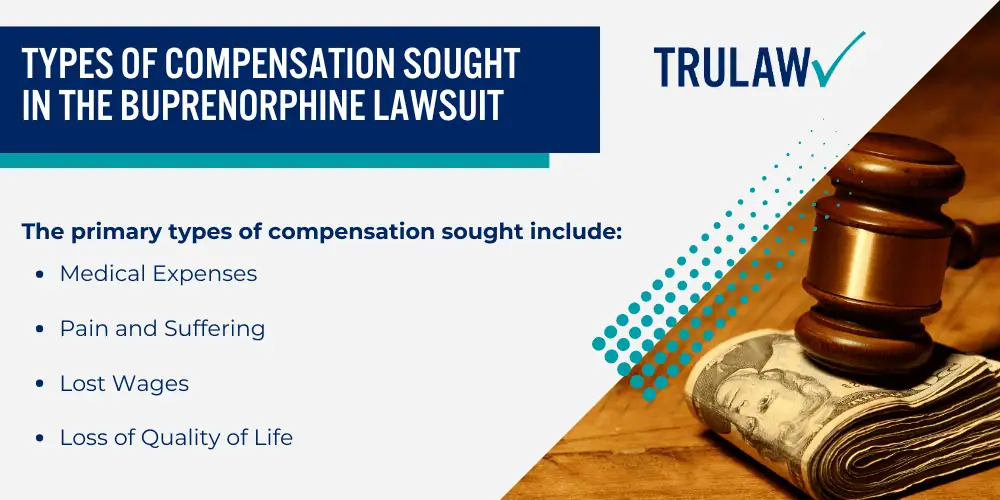
The primary types of compensation sought include:
- Medical Expenses: Plaintiffs seek compensation for the cost of dental treatments related to tooth decay and other dental issues caused by buprenorphine use. This includes costs for procedures such as fillings, crowns, extractions, implants, and other necessary dental care.
- Pain and Suffering: Compensation for pain and suffering addresses the physical and emotional distress caused by dental problems. This includes chronic pain, discomfort, and the psychological impact of tooth loss and other dental issues.
- Lost Wages: Some plaintiffs may have experienced a loss of income due to dental issues that impacted their ability to work. Compensation for lost wages covers the income lost during the recovery period and any future earning capacity affected by the dental problems.
- Loss of Quality of Life: Severe dental issues can significantly impact a person’s quality of life. Plaintiffs seek compensation for the diminished quality of life resulting from dental pain, the inability to eat certain foods, and the embarrassment or self-consciousness caused by dental problems.
These compensatory measures are designed to address the financial and emotional impacts of the plaintiffs’ dental injuries.
The various types of compensation reflect the comprehensive approach to addressing the plaintiffs’ claims.
They aim to provide financial relief and justice for the harms suffered due to Buprenorphine-related tooth decay.
Factors Influencing Buprenorphine Tooth Decay Settlements
Several factors influence the settlement amounts in the Buprenorphine Tooth Decay Lawsuit.
Understanding these factors helps plaintiffs and their attorneys navigate the settlement process and pursue fair compensation.
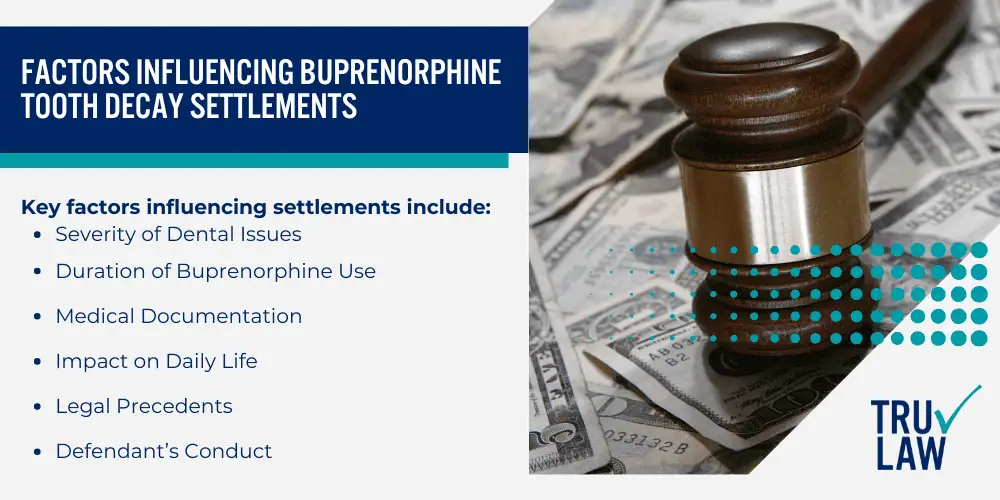
Key factors influencing settlements include:
- Severity of Dental Issues: The extent and severity of the dental problems experienced by the plaintiff play a significant role in determining the settlement amount. More severe cases involving extensive dental damage and complex treatments typically result in higher compensation.
- Duration of Buprenorphine Use: The length of time a plaintiff used buprenorphine can impact the settlement amount. Longer durations of use may correlate with more severe dental issues, influencing the compensation sought.
- Medical Documentation: Detailed and thorough medical documentation is crucial in substantiating the plaintiff’s claims. Dental records, treatment plans, and expert testimonies provide evidence of the dental issues and their link to buprenorphine use, strengthening the plaintiff’s case.
- Impact on Daily Life: The extent to which dental issues have affected the plaintiff’s daily life, including their ability to work, eat, and engage in social activities, influences the settlement amount. Significant impacts on quality of life may result in higher compensation.
- Legal Precedents: Previous settlements and verdicts in similar cases can influence the settlement amounts in the Buprenorphine Tooth Decay Lawsuit. Legal precedents provide a benchmark for determining fair compensation and guide settlement negotiations.
- Defendant’s Conduct: The behavior of the defendant, including their knowledge of the risks and actions taken (or not taken) to warn patients, can impact the settlement amount. Evidence of negligence or misconduct by the defendant may lead to higher compensation and punitive damages.
These factors collectively determine the potential settlements in the Buprenorphine Tooth Decay Lawsuit.
By considering the severity of dental issues, duration of use, medical documentation, impact on daily life, legal precedents, and the defendant’s conduct, plaintiffs and their attorneys can pursue fair and comprehensive compensation.
Suboxone Lawsuit Frequently Asked Questions
-
What is the Buprenorphine Tooth Decay Lawsuit?
The Buprenorphine Tooth Decay Lawsuit involves claims from individuals who suffered severe tooth decay and other dental problems after being prescribed Suboxone sublingual films to treat opioid addiction. These federal Suboxone lawsuits allege that the manufacturers failed to adequately warn about the potential dental side effects associated with the medication.
-
How do I know if I qualify for the Suboxone Tooth Decay Lawsuit?
If you were prescribed Suboxone film to treat opioid dependence and subsequently experienced significant dental issues like tooth decay, cavities, or tooth loss, you may be eligible to file a Suboxone tooth decay lawsuit. Suboxone lawyers can review your case to determine if you qualify and advise you on the statute of limitations for product liability claims in your state.
-
What compensation can plaintiffs seek in Suboxone Tooth Decay Lawsuits?
Plaintiffs in Suboxone Tooth Decay Lawsuits may seek compensation for dental expenses, pain and suffering, lost wages, and loss of quality of life related to the dental problems they experienced after using prescription Suboxone film. The specific compensation will depend on factors like the severity of the dental issues and the impact on the individual’s life.
-
How are Suboxone Tooth Decay Lawsuits being handled in court?
The Suboxone Tooth Decay Lawsuits have been consolidated into a Multidistrict Litigation (MDL) in the Northern District of Ohio. Bellwether trials are being conducted to help determine potential outcomes for other cases.
-
What should I do if I suffered dental problems after using Suboxone?
If you experienced tooth decay or other dental issues after being prescribed Suboxone sublingual films for opioid addiction treatment, it’s important to speak with experienced Suboxone lawyers who can evaluate your case and advise you on your legal options. Be mindful of the statute of limitations for product liability claims, which varies by state.
-
How can I find a lawyer for a Suboxone Tooth Decay Lawsuit?
If you or a loved one has suffered severe dental injuries after taking Buprenorphine/Suboxone, you may qualify to pursue compensation.
Contact TruLawsuit Info using the chat on this page to receive an instant case evaluation and join others filing in the Suboxone MDL today.
-
Is There a Suboxone Class Action Lawsuit?
No, there is not currently a Suboxone class action lawsuit. Instead, individual personal injury claims related to dental issues allegedly caused by Suboxone are being consolidated into a multidistrict litigation (MDL) within the Northern District of Ohio.

Managing Attorney & Owner
With over 25 years of legal experience, Jessica Paluch-Hoerman is an Illinois lawyer, a CPA, and a mother of three. She spent the first decade of her career working as an international tax attorney at Deloitte.
In 2009, Jessie co-founded her own law firm with her husband – which has scaled to over 30 employees since its conception.
In 2016, Jessie founded TruLaw, which allows her to collaborate with attorneys and legal experts across the United States on a daily basis. This hypervaluable network of experts is what enables her to share the most reliable, accurate, and up-to-date legal information with our readers!
Additional Suboxone Lawsuit resources on our website:
Here, at TruLaw, we’re committed to helping victims get the justice they deserve.
Alongside our partner law firms, we have successfully collected over $3 Billion in verdicts and settlements on behalf of injured individuals.
Would you like our help?
At TruLaw, we fiercely combat corporations that endanger individuals’ well-being. If you’ve suffered injuries and believe these well-funded entities should be held accountable, we’re here for you.
With TruLaw, you gain access to successful and seasoned lawyers who maximize your chances of success. Our lawyers invest in you—they do not receive a dime until your lawsuit reaches a successful resolution!
AFFF Lawsuit claims are being filed against manufacturers of aqueous film-forming foam (AFFF), commonly used in firefighting.
Claims allege that companies such as 3M, DuPont, and Tyco Fire Products failed to adequately warn users about the potential dangers of AFFF exposure — including increased risks of various cancers and diseases.
Depo Provera Lawsuit claims are being filed by individuals who allege they developed meningioma (a type of brain tumor) after receiving Depo-Provera birth control injections.
A 2024 study found that women using Depo-Provera for at least 1 year are five times more likely to develop meningioma brain tumors compared to those not using the drug.
Suboxone Tooth Decay Lawsuit claims are being filed against Indivior, the manufacturer of Suboxone, a medication used to treat opioid addiction.
Claims allege that Indivior failed to adequately warn users about the potential dangers of severe tooth decay and dental injuries associated with Suboxone’s sublingual film version.
Social Media Harm Lawsuits are being filed against social media companies for allegedly causing mental health issues in children and teens.
Claims allege that companies like Meta, Google, ByteDance, and Snap designed addictive platforms that led to anxiety, depression, and other mental health issues without adequately warning users or parents.
Transvaginal Mesh Lawsuits are being filed against manufacturers of transvaginal mesh products used to treat pelvic organ prolapse (POP) and stress urinary incontinence (SUI).
Claims allege that companies like Ethicon, C.R. Bard, and Boston Scientific failed to adequately warn about potential dangers — including erosion, pain, and infection.
Bair Hugger Warming Blanket Lawsuits involve claims against 3M — alleging their surgical warming blankets caused severe infections and complications (particularly in hip and knee replacement surgeries).
Plaintiffs claim 3M failed to warn about potential risks — despite knowing about increased risk of deep joint infections since 2011.
Baby Formula NEC Lawsuit claims are being filed against manufacturers of cow’s milk-based baby formula products.
Claims allege that companies like Abbott Laboratories (Similac) and Mead Johnson & Company (Enfamil) failed to warn about the increased risk of necrotizing enterocolitis (NEC) in premature infants.
Here, at TruLaw, we’re committed to helping victims get the justice they deserve.
Alongside our partner law firms, we have successfully collected over $3 Billion in verdicts and settlements on behalf of injured individuals.
Would you like our help?
